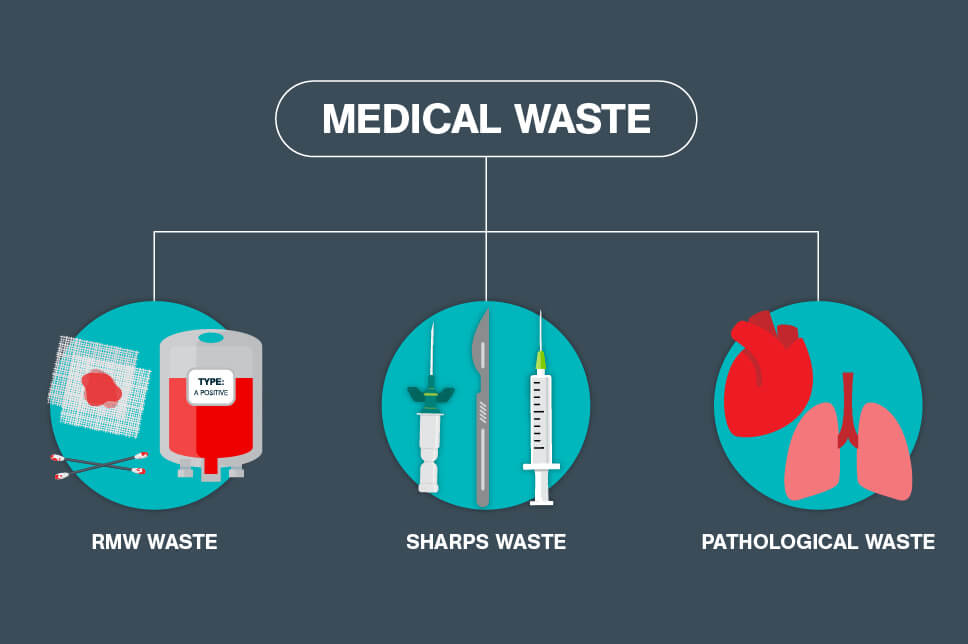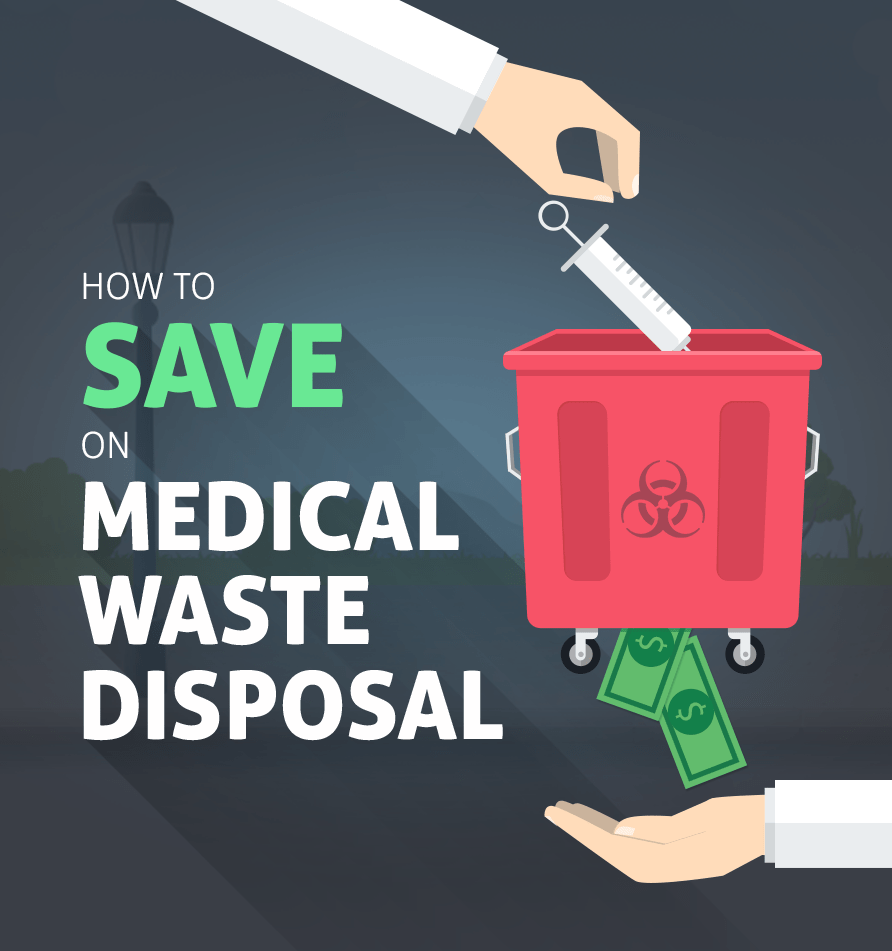Finest Practices for Medical Waste Management
Medical waste administration is a crucial aspect of medical care facilities' operations to make sure the safety and security of clients, staff, and the atmosphere. Implementing finest techniques in medical waste administration is important to lessen the threats related to contaminated materials. This consists of correct partition and categorization of waste, guaranteeing its safe storage space and labeling, sticking to regulatory guidelines, and utilizing effective disposal approaches. By following these ideal practices, health care centers can minimize the possibility for infections, injuries, and contamination triggered by inappropriate handling and disposal of medical waste. This introduction intends to supply a summary of the relevance of ideal techniques for clinical waste monitoring and the succeeding areas will certainly explore each technique thoroughly - medical waste removal.

Segregation and Categorization
In the area of clinical waste administration, appropriate segregation and classification are essential techniques for guaranteeing the safe and reliable disposal of healthcare-related products. Clinical waste is produced from different resources, including healthcare facilities, centers, laboratories, and various other healthcare facilities. It contains a variety of products, such as needles, syringes, bandages, handwear covers, and pharmaceutical waste.
Segregation entails the systematic splitting up of different sorts of clinical waste based on their qualities and possible dangers. This process helps to avoid cross-contamination and makes sure that each kind of waste is handled appropriately. Sharps waste, such as blades and needles, should be put in puncture-resistant containers to stop injuries and the spread of infectious diseases. Likewise, transmittable waste, such as blood-soaked bandages or cultures, must be set apart and treated individually to decrease the threat of spreading out microorganisms.
Categorization is the process of categorizing clinical waste right into various categories based on its potential hazards. These categories might consist of contagious waste, unsafe waste, pharmaceutical waste, and basic waste. By classifying waste, medical care centers can figure out the proper disposal techniques and ensure conformity with neighborhood regulations and standards.
Proper partition and categorization of clinical waste not only protect the health and wellness of medical care employees and the public yet likewise add to the general effectiveness and efficiency of waste monitoring. It reduces the threat of accidents, minimizes environmental effects, and advertises accountable garbage disposal techniques.
Proper Storage and Labeling
To guarantee the efficient and risk-free disposal of clinical waste, medical care facilities need to abide by correct storage and labeling methods. WasteX Medical Waste Disposal. Appropriate storage space and labeling play a crucial duty in maintaining the honesty of clinical waste monitoring systems and shielding the health and safety and security of healthcare workers, patients, and the public
When it involves storage space, it is vital to have actually assigned locations especially made for different kinds of clinical waste. These locations must be protected, well-ventilated, and furnished with ideal containers that meet regulatory criteria (medical waste disposal service). Segregation and classification of waste must likewise be thought about to avoid cross-contamination and possible hazards

Regular surveillance and examination of storage space locations and containers are vital to recognize any problems or infractions. Staff needs to be trained on proper storage space and labeling methods, stressing the relevance of conformity with laws and procedures.
Safe Transport and Handling
Guaranteeing the secure and correct transport and handling of medical waste is essential for preserving the honesty of waste administration systems and securing the health and wellness of all involved. Medical waste, that includes products infected with transmittable materials, drugs, and other dangerous substances, have to be transferred in a way that stops leaks, spills, and potential contamination.
To achieve safe transportation and handling, several best practices should be complied with. It is necessary to make use of leak-proof and puncture-resistant containers that are specifically designed for clinical waste. These containers need to be appropriately sealed and identified to avoid any kind of accidental exposure or mishandling. In addition, waste needs to be set apart based upon its nature and kind to avoid cross-contamination.
During transport, it is important to guarantee that waste containers are safely secured and stored in a secure way. Automobiles utilized for moving medical waste must be geared up with appropriate security features, such as spill control systems, to decrease the risk of any spills or leakages. Vehicle drivers should obtain training on proper handling and emergency situation reaction procedures to efficiently resolve any unpredicted events.
Moreover, the transport and handling of clinical waste need to adhere to all relevant laws and standards set forth by local, state, and government authorities. WasteX Medical Waste Disposal. medical waste disposal service. Routine assessments and audits need to be carried out to examine compliance and identify any kind of areas for enhancement
Compliance With Regulatory Guidelines
Preserving compliance with governing guidelines is crucial for effective clinical waste management. These standards are implemented to shield public health and the environment by making sure that medical waste is effectively handled, dealt with, and disposed of. Compliance with governing standards aids to avoid the spread of contagious illness, decrease prospective dangers, and lower the total effect of medical waste on the atmosphere.
To achieve compliance, medical care centers need to stay notified concerning the details guidelines governing medical waste monitoring in their territory. These laws may vary from country to he said country, and also within various states or areas. It is very important for health care centers to have a comprehensive understanding of these standards and to implement suitable approaches and protocols to ensure conformity.
One trick facet of conformity is the proper partition and labeling of various kinds of medical waste. This includes dividing sharps from other waste, as well as categorizing waste based on its prospective threats. Health care centers have to likewise make sure that clinical waste is stored in appropriate containers which these containers are appropriately identified and secured.
Moreover, conformity with regulative standards calls for medical care centers to establish correct training and education programs for team member entailed in medical waste management. This consists of providing training on waste partition, dealing with, and disposal procedures, as well as the appropriate use of individual protective equipment.
Normal tracking and audits are additionally necessary to guarantee ongoing compliance with governing standards. This entails carrying out regular assessments of waste storage locations, documenting waste administration treatments, and keeping documents of waste disposal.
Effective Disposal Techniques
Health care centers must employ effective disposal methods for proper monitoring of clinical waste. Inappropriate disposal of clinical waste can pose major health and wellness and ecological dangers. There are a number of techniques that can be made use of to effectively deal with medical waste, ensuring the safety of health care workers, people, and the basic public.
One typically made use of approach is incineration. Incinerators can safely shed medical waste at high temperatures, minimizing the volume and damaging any kind of potentially unsafe microorganisms. Incineration can be costly and might release damaging contaminants right into the air if not effectively managed.
An additional method is autoclaving, which includes subjecting the waste to high-pressure steam. This procedure eliminates germs, infections, and other bacteria, making the waste risk-free for disposal in normal waste streams. Autoclaving is a reliable and eco-friendly technique, but it needs specific equipment and skilled employees.
Chemical sanitation is likewise utilized sometimes, where liquid chemicals are put on the waste to sanitize it. This method is less generally utilized due to problems about the effectiveness of chemical sanitation and the potential for chemical deposits to infect the setting.
In addition to these methods, healthcare centers need to also execute appropriate segregation, product packaging, and labeling of clinical waste to guarantee its secure handling and disposal. Normal training and education of personnel on correct waste monitoring practices are important to maintaining effective disposal methods.
Conclusion
Finally, executing ideal techniques for clinical waste monitoring is crucial for ensuring the security of health care workers, clients, and the atmosphere. By properly setting apart and classifying waste, keeping and identifying it properly, ensuring safe transport and handling, abiding with governing standards, and employing reliable disposal approaches, medical care centers can successfully manage and reduce the dangers related to clinical waste. It is crucial for healthcare companies to prioritize and adhere to these best methods to maintain a safe and lasting health care atmosphere.
Clinical waste monitoring is a critical facet of medical care centers' procedures to guarantee the safety of people, team, and the atmosphere. Executing ideal methods in clinical waste administration is important to minimize the dangers connected with dangerous waste. These categories might include contagious waste, hazardous waste, pharmaceutical waste, and general waste.In final thought, implementing ideal practices for clinical waste administration is important for ensuring the security of medical care employees, patients, and the environment. By effectively classifying and setting apart waste, storing and identifying it properly, making certain risk-free transport and handling, complying with regulative guidelines, and utilizing reliable disposal methods, health care centers can properly manage and reduce the threats linked with clinical waste.